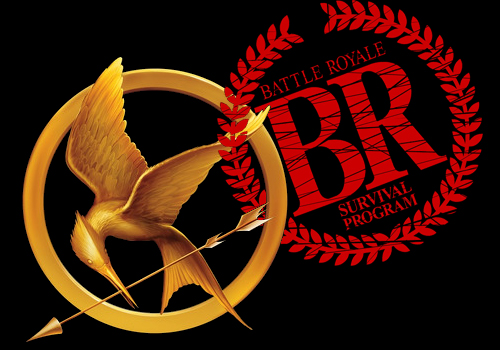Given the many parallels with Suzanne Collins' Hunger Games Trilogy, Catching Fire currently playing in cinemas across the US, and my own familiarity with the the novels and films, I thought it pertinent to talk a bit about Kinji Fukasaku's film adaptation of Koushun Takami's original Battle Royale. The story was also turned into two manga series, but since I haven't actually read them myself I cannot really comment. Same goes for the sequel film, BRII: Requiem, which I have yet to watch (you might think that I would have in preparation for this post, but nope). Anyway, Rachelle recommended the book to me a few semesters ago and I viewed the film shortly thereafter. Both the written and cinematic versions are excellent, but should they really be compared to The Hunger Games? Read on for my theory...
 |
| Not rated in the US, among other countries. T'is violent, though. |
Motifs between the two stories are very similar: using children as contestants, the fact that there is a one-girl/one-boy selection for entering the 'game', the events are televised, winners receive government-funded pensions, and the tracking collars in BR serve the same purpose as the surveillance technology located throughout the arena in HG. In both stories, the deaths of contestants are announced to the survivors, and even the distribution of weapons is comparable given that the Cornucopia in HG is a lot like the Okishima Island school in BR. There is also the important detail that some participants actually enjoy the battle, like the antagonistic Career Tributes, insane Mitsuko, and unfeeling Kazuo. The romance-y bits between the main protagonists in the first HG film and in BR can also be set side by side, though the chemistry between Shuya and Noriko is clearly more genuine given that Katniss only tries to gain sympathy from the audience when she snogs baker-boy. (Not that I begrudge that particular plot point: Katniss was trying to do whatever it took to make it out alive for the sake of her younger sister, Primrose). Most importantly, both fights are generally used to keep society in line through authoritarian power and fear tactics. Similar alternate timeline/futuristic post-war settings go unsaid. The final comparison I will make here is that of President Snow and Kinpatsu or Kitano in the BR novel and film, respectively. Since this is officially a film blog, I speak of Kitano when I say that he is a more redeemable antagonist than Snow (watch the movies to find out why!), but both are downright villainous creatures who subject children to abominable acts of violence.
Concerning differences...the HG series uses a reaping/lottery as opposed to the flat-out abduction in BR; the battle is said to be used for 'research purposes', but the game is an act of punishment for previous war crimes against the Capitol of Panem; BR sees fit to use 'forbidden zones' and exploding collars to enforce the rule that if no contestant is killed within 24 hours, all collars blow up and there is no 'winner'. This means that BR is far more unforgiving than HG in that there is no real way to win. Collins creates a bit of a deus ex machina by letting both Katniss and Peta live after their show involving poisonous nightlock berries, though of course she needed them the live for the two sequels and uprising against the Capitol. BR is also a shit ton more violent. The killing is present in both, but HG is more discreet—Cato's death by wolf mutts is about as gory as things get—as that is not really the focus of Collins' story.
On a completely separate note, books written by Eastern authors with issues concerning Japan's warlike history tend to include Western pop culture references [Murakami much?]. Takami used American music in his novel to create a sense of individualism in the face of the Republic of Greater East Asia and a regimented government. Japanese writings also tend to have more static, difficult to distinguish characters which Takami has described in his own work as being "all the same". Perhaps that makes their deaths easier to swallow despite the fact that we as readers actually experience each contestant's murder through their own eyes as opposed to just Katniss' POV. Collins obviously lends the HG series a lot more character development, and that is a rather pivotal difference between the two works.
 |
| Rated PG-13 for intense violent thematic material. |
On a completely separate note, books written by Eastern authors with issues concerning Japan's warlike history tend to include Western pop culture references [Murakami much?]. Takami used American music in his novel to create a sense of individualism in the face of the Republic of Greater East Asia and a regimented government. Japanese writings also tend to have more static, difficult to distinguish characters which Takami has described in his own work as being "all the same". Perhaps that makes their deaths easier to swallow despite the fact that we as readers actually experience each contestant's murder through their own eyes as opposed to just Katniss' POV. Collins obviously lends the HG series a lot more character development, and that is a rather pivotal difference between the two works.
 |
| Image taken from Taste of Cinema, which is actually kind of a tawdry news site... but the image was cool. |
How do you think the novels/films compare? Do you prefer one story over the other? Is the controversy justified? Were there too many spoilers in this post? Let me know in the comments below. :P



